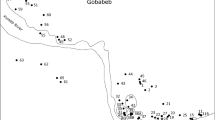Summary.
Queens of the neotropical ponerine ant Pachycondyla cf. 'inversa' may cooperate during colony founding. Pleometrosis leads to permanent primary polygyny, with queens still co-existing in the same nest when the colony has become mature. Using multilocus DNA-fingerprinting we examined the genetic structure of colonies. Nestmate queens are typically not close relatives. Excepting one pair of queens, which appeared to be closely related, the band-sharing coefficients of co-occurring queens were similar to the background similarity among individuals from different nests. In mature colonies, queens typically contribute equally to workers and sexuals. Only in one of seven colonies did one queen produce significantly more workers than the other. Polygynous ants with unrelated queens might provide an interesting system to test predictions from kin selection theory.
Similar content being viewed by others
Author information
Authors and Affiliations
Additional information
Received 19 December 2000; revised 31 January 2001; accepted 8 February 2001
Rights and permissions
About this article
Cite this article
Heinze, J., Trunzer, B., Hölldobler, B. et al. Reproductive skew and queen relatedness in an ant with primary polygyny. Insectes soc. 48, 149–153 (2001). https://doi.org/10.1007/PL00001758
Issue Date:
DOI: https://doi.org/10.1007/PL00001758




